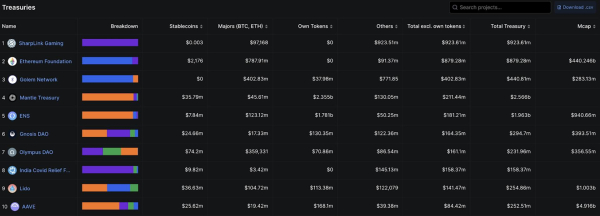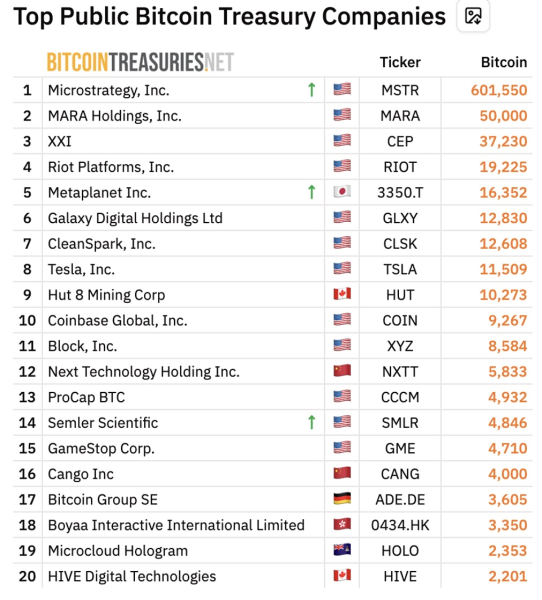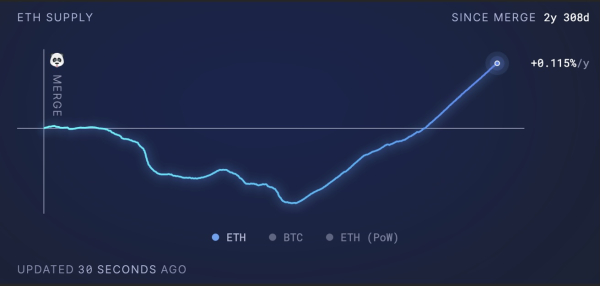Bybit Crypto Insights Report: Ether Becomes a Treasury Token

ETH turns up front
Ethereum has been thrust into the spotlight over the past week, marking a decisive break from the bearish sentiment that weighed on the asset during the first half of 2025. As of this writing, ETH has delivered a standout 7-day return of 23.9%, outperforming both Bitcoin (0.1%) and Solana (9.7%) over the same period. This sharp rebound has reignited market optimism, and positioned ETH as the focal point of community discussions.
The question is: What catalyzed this reversal?
ETH becomes the second treasury token

Source: DefiLlama
Ethereum’s core infrastructure and design remain unchanged, and there have been no overnight protocol upgrades or architectural shifts. However, news momentum has accelerated following BlackRock’s proposal to incorporate staking into its iShares Ethereum Trust ETF (ETHA), in response to the SEC’s regulatory clarity provided in May 2025. This move signals growing institutional interest in on-chain yield generation.
Investor enthusiasm has also been catalyzed by aggressive corporate accumulation. For example, SharpLink Gaming has acquired over 353,000 ETH, establishing itself as the largest Ether-holding treasury entity to date. BitMine has added 300,657 ETH to its balance sheet, backed by a 9.1% stake from Peter Thiel–linked investment vehicles. In parallel, crypto miner Bit Digital has disclosed a substantial 120,306 ETH holding.
Collectively, these developments reflect a strategic shift among TradFi players, many of whom are emulating Strategy’s precedent-setting Bitcoin accumulation. Ether is now widely regarded as the second treasury-grade digital asset — positioned just behind Bitcoin — marking a significant milestone in its institutional adoption journey.
However, the ETH treasury concept is at an early stage
.
Number of ETH
% of total circulating ETH
Holdings by SharpLink, BitMine and Bit Digital
773,963
0.64%
.
Number of BTC
% of total circulating BTC
Holding by Strategy
601,550
3.01%
Source: Bybit
As highlighted in the table above, ETH accumulation remains in its early phase. Notably, the share of circulating Bitcoin held by Strategy (formerly MicroStrategy) alone exceeds the combined holdings of the top three ETH accumulators when measured as a percentage of the total Ether supply. This disparity underscores the relative nascence of ETH’s adoption as a treasury-grade asset as compared to Bitcoin.
Leverage: What makes the ETH treasury better than Bitcoin
BTCS Inc. (NASDAQ: BTCS) reportedly holds 31,855 ETH, of which 16,232 ETH have been collateralized to secure a loan on AAVE. This exemplifies Ethereum’s extensive utility within decentralized finance (DeFi), particularly when contrasted with Bitcoin, which lacks comparable on-chain lending infrastructure. And while Strategy raises traditional finance (TradFi) bonds to leverage its Bitcoin positions, institutional and corporate actors can readily access DeFi lending protocols such as Aave (AAVE) in order to obtain ETH-backed liquidity.
DeFi’s inherent flexibility and accessibility allow for higher leverage levels on ETH accumulation without necessitating reliance on conventional lending channels. This dynamic introduces a compounding effect, whereby increased leverage amplifies buying power, potentially exacerbating imbalances between ETH supply and demand. As such, the decentralized nature of ETH-based financing could intensify its price trajectory and market volatility, relative to assets governed by stricter TradFi constraints.
ETH Spot ETFs still lag behind Bitcoin Spot ETFs

Source: BITCOINTREASURIES.NET
Corporate treasuries remain a minority in the acquisition of treasury tokens. For example, Bitcoin Spot ETFs hold a significantly larger amount of spot Bitcoin as compared to all corporate buyers (including Strategy). Specifically, the top 10 corporate owners of Bitcoin Strategy hold approximately 700,000 bitcoins, whereas all of the Bitcoin Spot ETFs collectively own approximately 1,459K bitcoins.
Bitcoin held by Bitcoin Spot ETFs and funds
approx. 1,459K
Percent of the total BTC circulating supply
6.9%
Ether held by ETH Spot ETFs
approx. 3,983K
As % of the total ETH circulating supply
3.3%
Source: Bybit
As illustrated in the table above, ETH Spot ETFs currently hold only half the percentage of the circulating supply, compared to Bitcoin Spot ETFs. This disparity underscores a significant gap in treasury accumulation, suggesting that Ether still has considerable room to grow in aligning with Bitcoin’s institutional adoption levels.
Still, Ether is a net inflationary token

Source: ultrasound.money
Since February 2025, Ethereum’s supply has turned net inflationary, driven by a reduction in on-chain activity and lower burn rates of transaction fees. This shift weakens the potential for a supply squeeze, particularly when large corporate treasuries accumulate ETH for long-term strategic purposes without clear short-term liquidation plans. In contrast, Bitcoin’s hard-coded supply cap of 21 million remains a core pillar of its value proposition, reinforcing scarcity and strengthening investor conviction through predictable issuance.
Nonetheless, ETH accumulation in recent months has been exceptionally robust — far outpacing its annual net issuance of approximately 836,000 ETH. This strong buy-side pressure indicates heightened demand from institutional players, DeFi protocols and treasury investors. If accumulation continues at this rate, Ether could face a structural supply imbalance, triggering a pronounced squeeze effect despite its inflationary supply profile. Such dynamics may accelerate upward price momentum and place ETH on a realistic trajectory to revisit its all-time high of $4,891 that was set in November 2021.
Moving forward, treasury token status and RWAs could provide support for ETH’s price movements
While ETH’s price struggles with declining on-chain transactions, Layer 2 (L2) solutions demonstrate significant growth. Daily L2 transactions now surpass those on L1s by a factor of 12.7x, and active L2 addresses outnumber L1s five to one. Furthermore, L2s host almost six times as many smart contracts, with over 500 daily interactions, and L2 DeFi velocity is 7.5x that of L1s.

Source: rwa.xyz
Despite transactions moving to L2s, capital remains predominantly concentrated within the Ethereum mainnet, with real-world assets (RWAs) increasingly gaining institutional traction. BlackRock’s tokenized treasury product, BUIDL, has recorded sustained inflows from TradFi institutions, signaling growing confidence in on-chain fixed income instruments.
In parallel, Ether (ETH) continues to solidify its status as a treasury-grade asset. Note that, if current adoption trends and macroeconomic conditions persist, ETH is well-positioned to reach the $5,000 mark by Q4 2025.
 Bitcoin
Bitcoin  Ethereum
Ethereum  Tether
Tether  XRP
XRP  USDC
USDC  Wrapped SOL
Wrapped SOL  TRON
TRON  Lido Staked Ether
Lido Staked Ether  Dogecoin
Dogecoin  Cardano
Cardano  Figure Heloc
Figure Heloc  WhiteBIT Coin
WhiteBIT Coin  Wrapped stETH
Wrapped stETH  Bitcoin Cash
Bitcoin Cash  Wrapped Bitcoin
Wrapped Bitcoin  USDS
USDS  Chainlink
Chainlink  Binance Bridged USDT (BNB Smart Chain)
Binance Bridged USDT (BNB Smart Chain)  LEO Token
LEO Token  WETH
WETH  Hyperliquid
Hyperliquid  Stellar
Stellar  Wrapped eETH
Wrapped eETH  Monero
Monero  Ethena USDe
Ethena USDe  Coinbase Wrapped BTC
Coinbase Wrapped BTC  Litecoin
Litecoin  Zcash
Zcash  Sui
Sui  Avalanche
Avalanche  Hedera
Hedera  Shiba Inu
Shiba Inu  Dai
Dai  sUSDS
sUSDS  World Liberty Financial
World Liberty Financial  USDT0
USDT0  Cronos
Cronos  PayPal USD
PayPal USD  Toncoin
Toncoin  Ethena Staked USDe
Ethena Staked USDe  Mantle
Mantle  Polkadot
Polkadot  Uniswap
Uniswap  Aave
Aave  USD1
USD1  Bittensor
Bittensor  Bitget Token
Bitget Token  Canton
Canton  MemeCore
MemeCore  Tether Gold
Tether Gold  Falcon USD
Falcon USD  OKB
OKB  NEAR Protocol
NEAR Protocol  Aster
Aster  BlackRock USD Institutional Digital Liquidity Fund
BlackRock USD Institutional Digital Liquidity Fund  Ethereum Classic
Ethereum Classic  Ethena
Ethena  Jito Staked SOL
Jito Staked SOL  Internet Computer
Internet Computer  Pi Network
Pi Network  Pepe
Pepe  Binance-Peg WETH
Binance-Peg WETH  Rain
Rain  Pump.fun
Pump.fun  Jupiter Perpetuals Liquidity Provider Token
Jupiter Perpetuals Liquidity Provider Token  HTX DAO
HTX DAO  Ondo
Ondo  syrupUSDC
syrupUSDC  PAX Gold
PAX Gold  Worldcoin
Worldcoin  Global Dollar
Global Dollar  BFUSD
BFUSD  Circle USYC
Circle USYC  KuCoin
KuCoin  Binance Bridged USDC (BNB Smart Chain)
Binance Bridged USDC (BNB Smart Chain)  Aptos
Aptos  Ripple USD
Ripple USD  Rocket Pool ETH
Rocket Pool ETH  POL (ex-MATIC)
POL (ex-MATIC)  syrupUSDT
syrupUSDT  Sky
Sky  Wrapped BNB
Wrapped BNB  Gate
Gate  Algorand
Algorand  Official Trump
Official Trump  Arbitrum
Arbitrum  Binance Staked SOL
Binance Staked SOL  VeChain
VeChain  Filecoin
Filecoin  Function FBTC
Function FBTC  Cosmos Hub
Cosmos Hub  USDtb
USDtb  Liquid Staked ETH
Liquid Staked ETH  Lombard Staked BTC
Lombard Staked BTC  Solv Protocol BTC
Solv Protocol BTC  NEXO
NEXO  Kinetiq Staked HYPE
Kinetiq Staked HYPE  Render
Render  Sei
Sei  Superstate Short Duration U.S. Government Securities Fund (USTB)
Superstate Short Duration U.S. Government Securities Fund (USTB)  OUSG
OUSG  PancakeSwap
PancakeSwap  Janus Henderson Anemoy AAA CLO Fund
Janus Henderson Anemoy AAA CLO Fund  Bonk
Bonk  Renzo Restaked ETH
Renzo Restaked ETH  Mantle Staked Ether
Mantle Staked Ether  Story
Story  Arbitrum Bridged WBTC (Arbitrum One)
Arbitrum Bridged WBTC (Arbitrum One)  Jupiter
Jupiter  clBTC
clBTC  Ondo US Dollar Yield
Ondo US Dollar Yield  Pudgy Penguins
Pudgy Penguins  Polygon Bridged USDC (Polygon PoS)
Polygon Bridged USDC (Polygon PoS)  Jupiter Staked SOL
Jupiter Staked SOL  USDai
USDai  Polygon PoS Bridged DAI (Polygon POS)
Polygon PoS Bridged DAI (Polygon POS)  SPX6900
SPX6900  StakeWise Staked ETH
StakeWise Staked ETH  Artificial Superintelligence Alliance
Artificial Superintelligence Alliance  Beldex
Beldex  Dash
Dash  Aerodrome Finance
Aerodrome Finance  L2 Standard Bridged WETH (Base)
L2 Standard Bridged WETH (Base)  MYX Finance
MYX Finance  Optimism
Optimism  Curve DAO
Curve DAO  Virtuals Protocol
Virtuals Protocol  Usual USD
Usual USD  Injective
Injective  tBTC
tBTC  Starknet
Starknet  Telcoin
Telcoin  Stacks
Stacks  Arbitrum Bridged WETH (Arbitrum One)
Arbitrum Bridged WETH (Arbitrum One)  Lido DAO
Lido DAO  Ultima
Ultima  Tezos
Tezos  USDD
USDD  Celestia
Celestia  Mantle Bridged USDT (Mantle)
Mantle Bridged USDT (Mantle)  TrueUSD
TrueUSD  cgETH Hashkey Cloud
cgETH Hashkey Cloud  Marinade Staked SOL
Marinade Staked SOL  The Graph
The Graph  AB
AB  Ether.fi
Ether.fi  GTETH
GTETH  Stader ETHx
Stader ETHx  Kaia
Kaia  Spiko EU T-Bills Money Market Fund
Spiko EU T-Bills Money Market Fund  FLOKI
FLOKI  GHO
GHO  Ether.Fi Liquid ETH
Ether.Fi Liquid ETH  Ethereum Name Service
Ethereum Name Service  DoubleZero
DoubleZero  Trust Wallet
Trust Wallet  Steakhouse USDC Morpho Vault
Steakhouse USDC Morpho Vault  IOTA
IOTA  Bitcoin SV
Bitcoin SV  Sun Token
Sun Token  Swell Ethereum
Swell Ethereum  Pendle
Pendle  sBTC
sBTC  JUST
JUST  BitTorrent
BitTorrent  Lorenzo Wrapped Bitcoin
Lorenzo Wrapped Bitcoin  Pyth Network
Pyth Network  Coinbase Wrapped Staked ETH
Coinbase Wrapped Staked ETH  Merlin Chain
Merlin Chain  Olympus
Olympus  Avalanche Bridged BTC (Avalanche)
Avalanche Bridged BTC (Avalanche)  Basic Attention
Basic Attention  dogwifhat
dogwifhat  The Sandbox
The Sandbox  Conflux
Conflux  Sonic
Sonic  Helium
Helium  AINFT
AINFT  Binance-Peg Dogecoin
Binance-Peg Dogecoin  Flow
Flow  Plasma
Plasma  Fartcoin
Fartcoin  Decred
Decred  ether.fi Staked ETH
ether.fi Staked ETH  Wrapped HYPE
Wrapped HYPE  BENQI Liquid Staked AVAX
BENQI Liquid Staked AVAX  EURC
EURC  JasmyCoin
JasmyCoin  GALA
GALA  Theta Network
Theta Network 